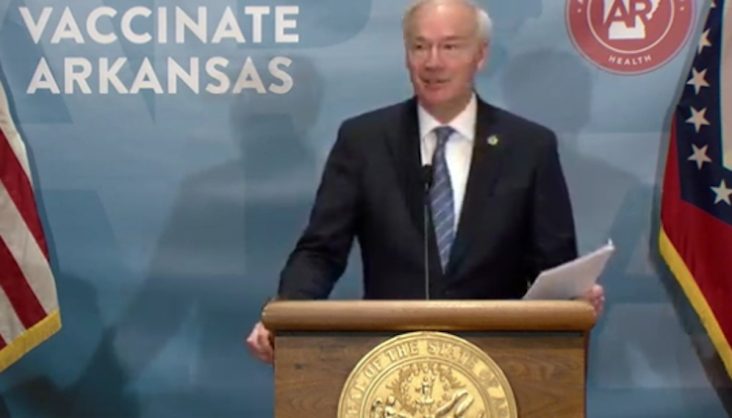Omicron may be peaking, but Arkansas’ healthcare system not ‘out of the woods’
by January 21, 2022 2:46 pm 1,753 views

Gov. Asa Hutchinson on Friday (Jan. 21) discusses COVID-19 cases in Arkansas.
There are signs infections from the Omicron variant of COVID-19 are peaking, but hospitals are likely to be stressed in the next few weeks, Gov. Asa Hutchinson and Arkansas Secretary of Health Dr. Jose Romero said Friday (Jan. 21). The glimmer of hope comes after weeks of new records set daily among Arkansans infected, being hospitalized, and dying.
The Arkansas Department of Health (ADH) on Friday reported 13,073 new known cases in the previous 24 hours, with the cumulative reaching 726,716 since the pandemic began. The ADH also showed 3,512 known active cases, bringing the known total to 101,141 – the first time over the 100,000 level. Deaths rose by 14 to a cumulative of 9,484 since the pandemic began. Hospitalizations rose by 18 to 1,658, another record for the metric. COVID patients on ventilators rose by eight to a total of 195.
The ADH reported 36 available ICU beds in Arkansas among the 1,187 total beds. The available number was down from 47 on Thursday. The report also showed 426 patients in ICU rooms, up from 403 on Thursday.
NOT ‘OUT OF THE WOODS’
As to positive signs, Dr. Romero said new infections in the 19-24 age group are declining, which is important because that was the first group to see a rapid rise in cases. Dr. Romero said if trends continue the state could begin to see a decline in cases as early as next week. But the threat will continue, he cautioned.
“This does not mean that we’re going to be out the woods. We’re still going to be having significant numbers of individuals being infected in the state. … While this may be a less severe infection on an individual basis, on a societal basis this is a severe outbreak of disease. It is taxing our healthcare systems,” he said.
Gov. Hutchinson expressed some frustration at what he called “hardened resistance” among the population to get vaccinated. There were only 5,155 new doses given in the previous 24 hours. Among the state’s eligible population, only 53.9% are fully vaccinated, with 13.1% partially vaccinated, according to the ADH.
“Our doses given remains a concern to me. I just think the confusing messages that we’ve seen nationally, the debate online, we’re slowing down the progress we’ve made on our vaccination program. With 5,000 being given at really the height of the pandemic, we’d like to see that number, obviously, much higher,” Gov. Hutchinson said.
BAPTIST HEALTH, SCHOOL NUMBERS
Other potential good news came from Greg Crain, senior vice president and administrator at Little Rock-based Baptist Health. He said the system now has a record high of 333 COVID patients in its network, with 95 in ICU and 52 of those on ventilators. However, he said the number of Baptist Health employees out sick or having to quarantine has in recent days declined from a high of 584 to 259. But, as did Dr. Romero, Crain warned that COVID will continue to infect and kill people, especially those not vaccinated.
“I worry that the general public doesn’t think that COVID is a threat to them, that the Omicron variant is not a threat. But people get very, very sick. The majority of those in critical care are not vaccinated. Clearly, the vaccines provide protection,” Crain said.
The ADH reports that 75.2% of new cases are among the vaccinated, with 84% who are hospitalized and 84.3% who die also unvaccinated.
Another potential sign of an easing surge is that Arkansas public school districts having to close a campus fell from 108 last week to 49 this week, according to the Arkansas Department of Education.
But COVID is likely to remain a problem for school districts. The Arkansas Center for Health Improvement (ACHI) reported Thursday that for the first time all of Arkansas’s 234 contiguous public school districts have COVID infection rates of 50 or more new known infections per 10,000 district residents over a 14-day period, up from 226. The report was based on ADH data provided Jan. 17.
“Every school district being in red, purple, or pink on our map means that COVID-19 is spreading uncontrolled in all our communities.” ACHI President and CEO Dr. Joe Thompson said in a statement. “In nearly three-fourths of the districts, at least 2% of the local population is infected. In four districts, more than 5% of the population, or one out of every 20 people, is newly infected.”
